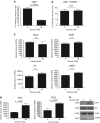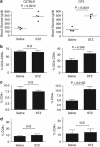Anti-apoptotic effect of hyperglycemia can allow survival of potentially autoreactive T cells
- PMID: 21164518
- PMCID: PMC3131907
- DOI: 10.1038/cdd.2010.163
Anti-apoptotic effect of hyperglycemia can allow survival of potentially autoreactive T cells
Erratum in
- Cell Death Differ. 2012 Nov;19(11):1892
Abstract
Thymocyte development is a tightly controlled multi-step process involving selective elimination of self-reactive and non-functional T cells by apoptosis. This developmental process depends on signaling by Notch, IL-7 and active glucose metabolism. In this study, we explored the requirement of glucose for thymocyte survival and found that in addition to metabolic regulation, glucose leads to the expression of anti-apoptotic genes. Under hyperglycemic conditions, both mouse and human thymocytes demonstrate enhanced survival. We show that glucose-induced anti-apoptotic genes are dependent on NF-κB p65 because high glucose is unable to attenuate normal ongoing apoptosis of thymocytes isolated from p65 knockout mice. Furthermore, we demonstrate that in vivo hyperglycemia decreases apoptosis of thymocytes allowing for survival of potentially self-reactive thymocytes. These results imply that hyperglycemic conditions could contribute to the development of autoimmunity through dysregulated thymic selection.
© 2011 Macmillan Publishers Limited
Figures






Similar articles
-
Survival of Single Positive Thymocytes Depends upon Developmental Control of RIPK1 Kinase Signaling by the IKK Complex Independent of NF-κB.Immunity. 2019 Feb 19;50(2):348-361.e4. doi: 10.1016/j.immuni.2019.01.004. Epub 2019 Feb 5. Immunity. 2019. PMID: 30737145 Free PMC article.
-
Inhibitor of kappa B epsilon (IκBε) is a non-redundant regulator of c-Rel-dependent gene expression in murine T and B cells.PLoS One. 2011;6(9):e24504. doi: 10.1371/journal.pone.0024504. Epub 2011 Sep 6. PLoS One. 2011. PMID: 21915344 Free PMC article.
-
The anti-apoptotic activities of Rel and RelA required during B-cell maturation involve the regulation of Bcl-2 expression.EMBO J. 2000 Dec 1;19(23):6351-60. doi: 10.1093/emboj/19.23.6351. EMBO J. 2000. PMID: 11101508 Free PMC article.
-
NF-kappaB p50/RelA and c-Rel-containing dimers: opposite regulators of neuron vulnerability to ischaemia.J Neurochem. 2009 Jan;108(2):475-85. doi: 10.1111/j.1471-4159.2008.05783.x. J Neurochem. 2009. PMID: 19094066
-
Apoptosis during negative selection of autoreactive thymocytes.Curr Opin Immunol. 2007 Oct;19(5):510-5. doi: 10.1016/j.coi.2007.06.001. Epub 2007 Jul 25. Curr Opin Immunol. 2007. PMID: 17656079 Review.
Cited by
-
Deficiency of Nuclear Factor-κB c-Rel Accelerates the Development of Autoimmune Diabetes in NOD Mice.Diabetes. 2016 Aug;65(8):2367-79. doi: 10.2337/db15-1607. Epub 2016 May 23. Diabetes. 2016. PMID: 27217485 Free PMC article.
-
Altered proportions of naïve, central memory and terminally differentiated central memory subsets among CD4+ and CD8 + T cells expressing CD26 in patients with type 1 diabetes.J Clin Immunol. 2011 Dec;31(6):977-84. doi: 10.1007/s10875-011-9573-z. Epub 2011 Sep 2. J Clin Immunol. 2011. PMID: 21887518
-
Too sweet to resist: Control of immune cell function by O-GlcNAcylation.Cell Immunol. 2018 Nov;333:85-92. doi: 10.1016/j.cellimm.2018.05.010. Epub 2018 Jun 2. Cell Immunol. 2018. PMID: 29887419 Free PMC article. Review.
-
The NF-κB Pathway and Cancer Stem Cells.Cells. 2016 Apr 6;5(2):16. doi: 10.3390/cells5020016. Cells. 2016. PMID: 27058560 Free PMC article. Review.
-
The Warburg effect dictates the mechanism of butyrate-mediated histone acetylation and cell proliferation.Mol Cell. 2012 Nov 30;48(4):612-26. doi: 10.1016/j.molcel.2012.08.033. Epub 2012 Oct 11. Mol Cell. 2012. PMID: 23063526 Free PMC article.
References
-
- Patterson CC, Dahlquist GG, Gyurus E, Green A, Soltesz G. Incidence trends for childhood type 1 diabetes in Europe during 1989–2003 and predicted new cases 2005–20: a multicentre prospective registration study. Lancet. 2009;373:2027–2033. - PubMed
-
- Ciofani M, Zuniga-Pflucker JC. Notch promotes survival of pre-T cells at the beta-selection checkpoint by regulating cellular metabolism. Nat Immunol. 2005;6:881–888. - PubMed
-
- Hayday AC, Pennington DJ. Key factors in the organized chaos of early T cell development. Nat Immunol. 2007;8:137–144. - PubMed
-
- Zhang N, Hartig H, Dzhagalov I, Draper D, He YW. The role of apoptosis in the development and function of T lymphocytes. Cell Res. 2005;15:749–769. - PubMed
-
- Greiner EF, Guppy M, Brand K. Glucose is essential for proliferation and the glycolytic enzyme induction that provokes a transition to glycolytic energy production. J Biol Chem. 1994;269:31484–31490. - PubMed
Publication types
MeSH terms
Substances
Grants and funding
LinkOut - more resources
Full Text Sources
Other Literature Sources
Molecular Biology Databases

